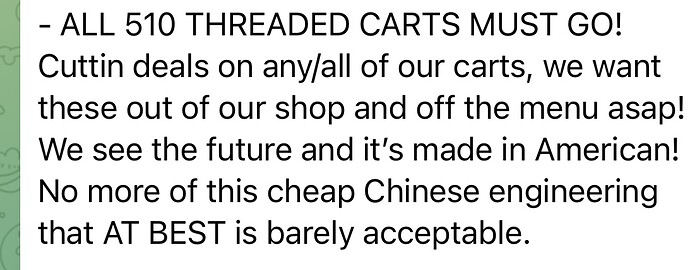Manufacturing in the US may be possible one day, but would require some serious investment to be competitive.
I’ve set up four factories in China now and worked with raw material suppliers for the past four years in Shenzhen. Metals, Glass, Plastics, Ceramics, cotton, etc.
510-thread could easily be manufactured in the US, but unfortunately the current design of these carts is very difficult for automation. Therefore, the majority of not all employ human assembly lines.
All these raw materials (components) could be imported and assembled locally, but would likely be 5-6x the labor cost per unit.
In China, the labor costs per cartridge is roughly $.10-$.12 per unit and the cost of raw materials being roughly $.50 to $.60 per unit.
Also, because of the highly regulated environment of the U.S., real estate costs, insurance and taxes, you’re likely at over $2.00 per unit for a cartridge that can be imported for roughly $1.00 into the US and landed at $1.35 once you clear shipping and import taxes.
If people are willing to pay $2.60 to $2.70 per cartridge, then there is a business model there but unfortunately, I sense that while everyone wants “Made in the USA” they are unwilling to operate at such a clear disadvantage.
If you could employ automation, then this would be much more possible. The cost of an automated production line in Shenzhen is about $300K to set up that could potentially produce 1M carts per month. I’d imagine this is maybe $1.5M for the same in the US.
These estimates only include the tank. The tip costs would need to be factored in as well.
